Parkinson's disease alters the composition of subgingival microbiome
- PMID: 37649970
- PMCID: PMC10464550
- DOI: 10.1080/20002297.2023.2250650
Parkinson's disease alters the composition of subgingival microbiome
Abstract
Aim: The current study aimed to test the hypothesis that Parkinson's disease exacerbates periodontitis by altering its microbiome.
Materials and methods: Clinical periodontal parameters were recorded. Subgingival samples from healthy controls, periodontitis patients (PD), and Parkinson's patients with periodontitis (PA+PD) were analyzed using the checkerboard DNA-DNA hybridization technique for targeting 40 bacterial species typically associated with periodontal disease and health. Next-generation sequencing (NGS) of the 16S ribosomal RNA gene (V1-V3 regions) was performed to analyze the microbiome comprehensively.
Results: Parkinson's patients had mild-to-moderate motor dysfunctions. Bleeding on probing was significantly increased in the PA+PD group compared to PD (p < 0.05). With checkerboard analysis, PA was associated with increased Treponema socranskii (p = 0.0062), Peptostreptococcaceae_[G-6] [Eubacterium]_nodatum (p = 0.0439), Parvimona micra (p < 0.0001), Prevotella melaninogenica (p = 0.0002), Lachnoanaerobaculum saburreum (p < 0.0001), and Streptococcus anginosus (p = 0.0020). Streptococcus intermedia (p = 0.0042), P.nodatum (p = 0.0022), P. micra (p = 0.0002), Treponema denticola (p = 0.0045), L.saburreum (p = 0.0267), P.melaninogenica (p = 0.0017), Campylobacter rectus (p = 0.0020), and T.socranskii (p = 0.0002) were higher; Aggregatibacter actinomycetemcomitans (p = 0.0072) was lower in deep pockets in the PA+PD compared to PD. Schaalia odontolytica (p = 0.0351) and A.actinomycetemcomitans (p = 0.002) were lower; C.rectus (p = 0.0002), P. micra (p = 0065), Streptococcus constellatus (p = 0.0151), T.denticola (p = 0.0141), P.melaninogenica (p = 0.0057), and T.socranskii (p = 0.0316) were higher in shallow pockets in the PA+PD. Diversity decreased in PD (p = 0.001) and PA+PD (p = 0.026) compared to control, with minimal differences in alpha and beta diversities among PD and PA+PD based on NGS results.
Conclusion: These data demonstrated that Parkinson's disease modifies PD-associated subgingival microbiome.
Keywords: Checkerboard; Parkinson’s disease; microbiome; microbiota; pathogenesis; periodontitis.
© 2023 The Author(s). Published by Informa UK Limited, trading as Taylor & Francis Group.
Conflict of interest statement
No potential conflict of interest was reported by the author(s).
Figures

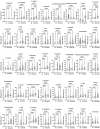

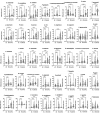

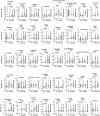
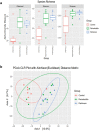

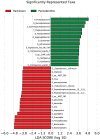
Similar articles
-
Oral and gut microbial profiling in periodontitis and Parkinson's disease.J Oral Microbiol. 2024 Mar 21;16(1):2331264. doi: 10.1080/20002297.2024.2331264. eCollection 2024. J Oral Microbiol. 2024. PMID: 38528960 Free PMC article.
-
Does pregnancy have an impact on the subgingival microbiota?J Periodontol. 2009 Jan;80(1):72-81. doi: 10.1902/jop.2009.080012. J Periodontol. 2009. PMID: 19228092
-
Does obesity influence the subgingival microbiota composition in periodontal health and disease?J Clin Periodontol. 2016 Dec;43(12):1003-1012. doi: 10.1111/jcpe.12634. Epub 2016 Oct 26. J Clin Periodontol. 2016. PMID: 27717180
-
The Effect of Non-Surgical Periodontal Therapy on Subgingival Microbiota: A Systematic Review and Meta-Analysis.J Periodontal Res. 2025 May 9. doi: 10.1111/jre.13409. Online ahead of print. J Periodontal Res. 2025. PMID: 40347039 Review.
-
Influence of obesity on subgingival microbiota composition in subjects with different periodontal status: a systematic review.Rev Cient Odontol (Lima). 2024 Mar 30;12(1):e187. doi: 10.21142/2523-2754-1201-2024-187. eCollection 2024 Jan-Mar. Rev Cient Odontol (Lima). 2024. PMID: 39015311 Free PMC article. Review.
Cited by
-
Oral and gut microbial profiling in periodontitis and Parkinson's disease.J Oral Microbiol. 2024 Mar 21;16(1):2331264. doi: 10.1080/20002297.2024.2331264. eCollection 2024. J Oral Microbiol. 2024. PMID: 38528960 Free PMC article.
-
Brain-Region-Specific Differences in Protein Citrullination/Deimination in a Pre-Motor Parkinson's Disease Rat Model.Int J Mol Sci. 2024 Oct 17;25(20):11168. doi: 10.3390/ijms252011168. Int J Mol Sci. 2024. PMID: 39456949 Free PMC article.
-
Association between oral dysbiosis and Parkinson's disease: a systematic review.Front Cell Infect Microbiol. 2025 May 13;15:1564362. doi: 10.3389/fcimb.2025.1564362. eCollection 2025. Front Cell Infect Microbiol. 2025. PMID: 40433667 Free PMC article.
-
Exploring the Association between Anxiety, Depression, and Gut Microbiota during Pregnancy: Findings from a Pregnancy Cohort Study in Shijiazhuang, Hebei Province, China.Nutrients. 2024 May 12;16(10):1460. doi: 10.3390/nu16101460. Nutrients. 2024. PMID: 38794698 Free PMC article.
References
Grants and funding
LinkOut - more resources
Full Text Sources
Research Materials
Miscellaneous
